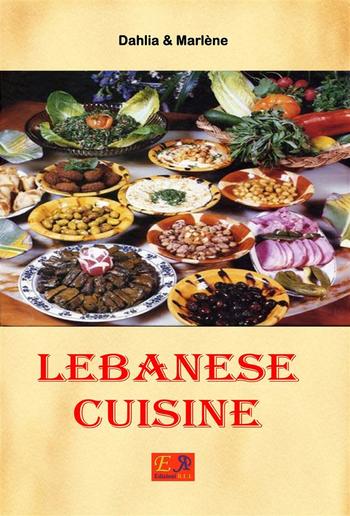
Dahlia & Marlène - Lebanese Cuisine
Lebanese Cuisine
Dahlia & Marlène
Description
New Edition.
Lebanese cuisine is perhaps one of the most typical expression of Middle Eastern cuisine, extremely diverse and heavily influenced by the Arab-Muslim tradition.
This is especially noticeable in the prevalence of the use of the lamb, the abundant use of nuts, especially almonds and pine nuts, and dressings made from lemon juice.
Lebanese cuisine is a delight for hovering. Using fresh ingredients and flavorful spices and refined, the Lebanese have acquired the best aspects of Turkish and Arabic giving them a French twist.
The soups are light, enriched with lentils and spiced with cinnamon.
Dish is the tabbouleh, a salad of parsley, tomatoes and burghul, with many variations, the taste reminds decidedly lemon.
Diffuse are stuffed vegetables such as pumpkins, eggplant and chard stuffed with vegetarian, meat and rice and meat and pine nuts.
It is commonly found on the tables the "kabees", Lebanese pickles, but also a lot of salads and fruits.
Even in wine Lebanon is unmatched with other Middle Eastern cultures.
There is an oasis in Lebanon that the story was not touched by Islamic fundamentalism, nor by conflicts: the Bekaa Valley, a stronghold of one of the oldest wine production.
In Lebanon were the Phoenicians, four thousand years ago, to bring the culture of the vine.
The cultivation of the vine was maintained and even enhanced with the arrival of the Orthodox Christian community in the territory, although production was limited to the consumption for ecclesiastical rites and their canteens.
Recipes on the volume:
Ashta
Awamaat
Baba Ghanoush
Babaghannush
baklava
Batata Harra
Burghul with walnuts
Grouper with sauce Tarator
Cream with cumin (mighli)
Eggah with leeks
Spinach dumplings
Falafel
Fattoush
Ganache Milk
Halawet el jibn
Hummus
Imjadra
Eggplant salad
Lebanese Salad
Chicken roulade with sage
Kafta meshwi
Kibbee
Laban b'khiar (cucumber salad with yoghurt)
Lahm biajin (pizzas with meat)
Makloubeh
Manakiche b'zaatar (Pizza Lebanese thyme)
Mjadarah
Musakhan
Mutabbal Koosa
Nkhaat Mtabbli
Pita bread
Pastries with walnuts and almonds
Baked fish with tahini sauce
Fish with saffron
Meatloaf
Rice to Lebanon
Salami Dates
Salata Al-Filfil
Tarator sesame sauce
Sugar syrup
Shish Tavuk
Tabuleh
Tabuleh curry
Warak Inab
White Coffee
Za'atar

